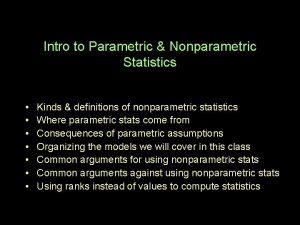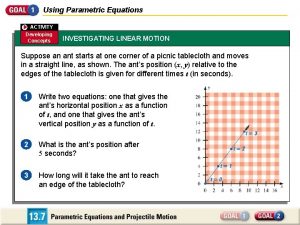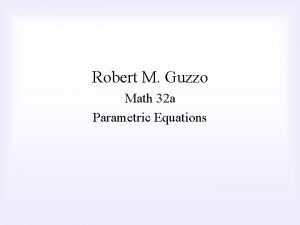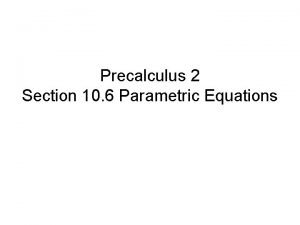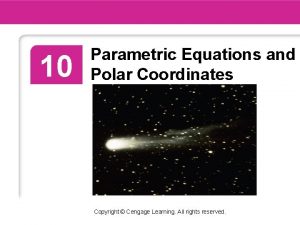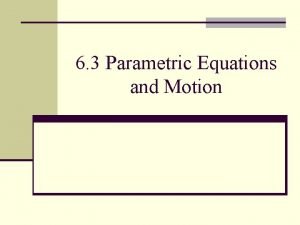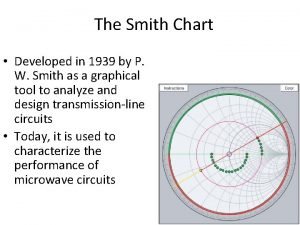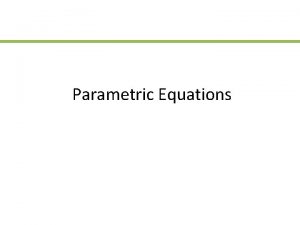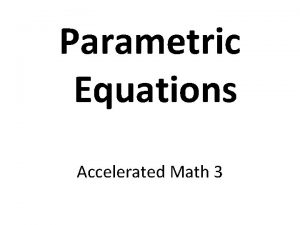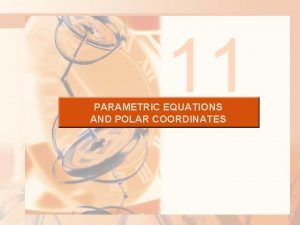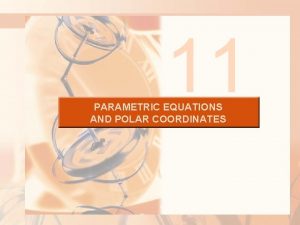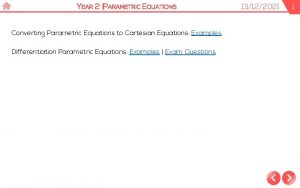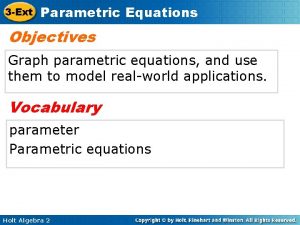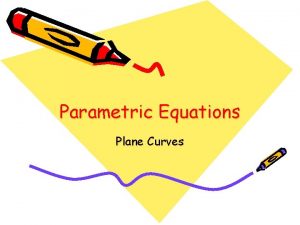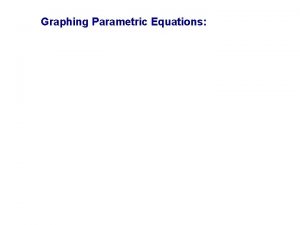Using Parametric Equations ACTIVITY Developing Concepts INVESTIGATING LINEAR










- Slides: 10

Using Parametric Equations ACTIVITY Developing Concepts INVESTIGATING LINEAR MOTION Suppose an ant starts at one corner of a picnic tablecloth and moves in a straight line, as shown. The ant’s position (x, y) relative to the edges of the tablecloth is given for different times t (in seconds). 1 Write two equations: one that gives the ant’s horizontal position x as a function of t, and one that gives the ant’s vertical position y as a function of t. 2 What is the ant’s position after 5 seconds? 3 How long will it take the ant to reach an edge of the tablecloth?

Using Parametric Equations In the previous slide, you may have noticed that you can write a pair of equations that express x and y in terms of a third variable t. These equations, x = f (t) and y = g(t), are called parametric equations, and t is called the parameter.

Graphing a Set of Parametric Equations Graph x = 3 t – 12 and y = – 2 t + 3 for 0 ≤ t� ≤ 5. SOLUTION Begin by making a table of values. t 0 1 2 3 4 5 x – 12 – 9 – 6 – 3 0 3 y 3 1 – 3 – 5 – 7 Plot the points (x, y) given in the table: (– 12, 3), (– 9, 1), (– 6, – 1), (– 3, – 3), (0, – 5), (3, – 7) Then connect the points with a line segment as shown.

Eliminating the Parameter Write an x y -equation for the parametric equations in the previous example: x = 3 t – 12 and y = – 2 t + 3 for 0 ≤ t ≤ 5. State the domain for the equation. SOLUTION Then substitute for t in the other parametric equation. First solve one of the parametric equations for t. x = 3 t – 12 Write original equation. y = – 2 t + 3 Write original equation. x + 12 = 3 t Add 12 to each side. 1 y = – 2 t( + 3 x + 4) + 3 3 Substitute for t. 1 x+4=t 3 Multiply each side by y=– 2 x– 5 3 Simplify. 1. 3 This process is called eliminating the parameter because the parameter t is not in the final equation. When t = 0, x = – 12 and when t = 5, x = 3. So, the domain of the x y -equation is – 12 ≤ x ≤ 3.

Using Parametric Equations Consider an object that is moving with constant speed v along a straight line that makes an angle measured counterclockwise from a line parallel to the x -axis. The position of the object at any time t can be represented by the parametric equations x = (v cos ) t + x 0 y = (v sin ) t + y 0 where (x 0 , y 0 ) is the object’s location when t = 0.

Modeling Linear Motion Write a set of parametric equations for the airplane shown, given that its speed is 306 feet per second. SOLUTION The angle of elevation is = tan – 1 ( ) ≈ 11. 3°. 1200 6000 Using v = 306, = 11. 3°, and (x 0 , y 0) = (0, 0), you can write the following. x = (v cos ) t + x 0 x ≈ (306 cos 11. 3°) t + 0 ≈ 300 t and y = (v sin ) t + y 0 y ≈ (306 sin 11. 3°) t + 0 ≈ 60 t

Modeling Projectile Motion Parametric equations can also be used to model nonlinear motion in a plane. For instance, consider an object that is projected into the air at an angle with an initial speed v. The object’s parabolic path can be modeled with the parametric equations x = (v cos ) t + x 0 y=– 1 2 g t + (v sin ) t + y 0 2 where (x 0, y 0) is the object’s location when t = 0. The constant g is the acceleration due to gravity. Its value is 32 ft/sec 2 or 9. 8 m/sec 2. (Note that this model neglects air resistance. )

Modeling Projectile Motion PUMPKIN TOSSING In a pumpkin tossing contest in Morton, Illinois, a contestant won the catapult competition by using two telephone poles, huge rubber bands, and a power winch. Suppose the pumpkin was launched with an initial speed of 125 feet per second, at an angle of 45°, and from an initial height of 25 feet.

Modeling Projectile Motion PUMPKIN TOSSING In a pumpkin tossing contest in Morton, Illinois, a contestant won the catapult competition by using two telephone poles, huge rubber bands, and a power winch. Suppose the pumpkin was launched with an initial speed of 125 feet per second, at an angle of 45°, and from an initial height of 25 feet. Write a set of parametric equations for the motion of the pumpkin. SOLUTION Using v = 125 ft/sec, = 45°, and (x 0 , y 0) = (0, 25), you can write the following. x = (v cos ) t + x 0 ≈ 88. 4 t and y=– 1 2 g t + (v sin ) t + y 0 2 ≈ – 16 t 2 + 88. 4 t + 25

Modeling Projectile Motion PUMPKIN TOSSING In a pumpkin tossing contest in Morton, Illinois, a contestant won the catapult competition by using two telephone poles, huge rubber bands, and a power winch. Suppose the pumpkin was launched with an initial speed of 125 feet per second, at an angle of 45°, and from an initial height of 25 feet. Use the equations x 88. 4 t and y ≈ – 16 t 2 + 88. 4 t + 25 to find how far the pumpkin traveled. SOLUTION The pumpkin hits the ground when y = 0. – 16 t 2 + 88. 4 t + 25 = y Write parametric equation for y. – 16 t 2 + 88. 4 t + 25 = y 0 Substitute 0 for y. – 88. 4 ± (88. 4) 2 – 4(– 16)(25) t= 2(– 16) t ≈ 5. 8 seconds Use the quadratic formula to find t. Simplify and choose positive t-value. When t = 5. 8 seconds, the pumpkin’s location will have an x-value of x = (88. 4)(5. 8) ≈ 513 feet. So, the pumpkin traveled about 513 feet.
 Parametric test and non parametric test
Parametric test and non parametric test Nonparametric tests
Nonparametric tests Parametric and non parametric algorithms
Parametric and non parametric algorithms Parametric
Parametric Linear motion equations
Linear motion equations Parametric equations word problems
Parametric equations word problems Parametric equation of a line
Parametric equation of a line Polar curve
Polar curve Parametric equations of motion
Parametric equations of motion How to solve parametric equations
How to solve parametric equations Smith chart parametric equations
Smith chart parametric equations



